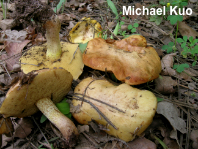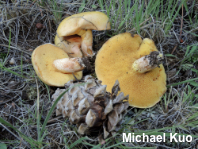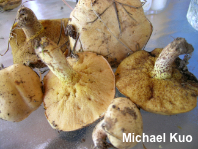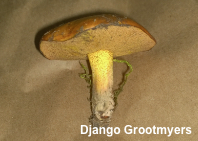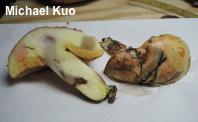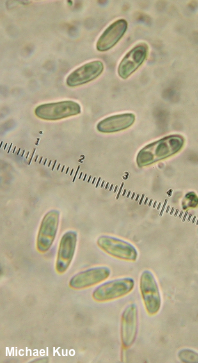| Major Groups > Boletes > Suillus > Suillus kaibabensis |

|
Suillus kaibabensis [ Basidiomycota > Boletales > Suillaceae > Suillus . . . ] by Michael Kuo Suillus kaibabensis is one of several species in western North America that are similar to the European species Suillus granulatus, featuring a yellow-brown cap, yellow pores that are not arranged in a strongly boletinoid pattern, and a stem that develops cinnamon brown glandular dots. However, Suillus kaibabensis is a mycorrhizal associate of ponderosa pine, and is thus found only in the host tree's natural range. Morphologically, the glandular dots of Suillus kaibabensis are more developed, often becoming quite large with maturity—and its cap tends a bit more in the yellow direction. Another granulatus-like associate of ponderosa pine, Suillus wasatchicus, differs in its pore surface, which is pale orange and covered with glandular dots in youth; additionally its cap turns purple (rather than gray) with KOH, and its spores tend to be slightly smaller. In eastern North America, Suillus weaverae can look similar, but is associated with eastern white pine and features a darker brown cap and less conspicuous glandular dots. Thanks to Django Grootmyers for documenting, collecting, and preserving Suillus kaibabensis for study; his collections are deposited in The Herbarium of Michael Kuo. Description: Ecology: Mycorrhizal with ponderosa pine; growing scattered or gregariously in monsoon season (late July through early September); originally described from Arizona; widespread in the southern Rocky Mountains; possibly to be expected elsewhere within the range of ponderosa pine. The illustrated and described collections are from Colorado. Cap: 4–15 cm; convex becoming broadly convex or flat; sticky when fresh; bald; brownish yellow to dull yellow or tan, sometimes with a few reddish streaks and areas; the margin often featuring a thin, soft, whitish, sterile zone, especially in young specimens. Pore Surface: Buff to yellowish or yellow, becoming brownish yellow with age; sometimes becoming reddish-dotted with maturity; not bruising, or sometimes bruising brownish; 2–3 angular pores per mm; tubes to 12 mm deep; often featuring scattered glandular dots. Stem: 3–6 cm long; 1–3 cm thick; more or less equal, or tapered to base; dry; yellowish to bright yellow at the apex, whitish to yellowish or brownish below; when young with inconspicuous, yellow to cinnamon glandular dots—but at maturity covered with conspicuous reddish brown glandular dots that frequently become large and elongated with maturity, resulting in smears and lines; without a ring. Flesh: Yellowish to yellow; not staining on exposure. Odor and Taste: Not distinctive. Chemical Reactions: Ammonia reddish to pink on cap surface; pink to pinkish orange on flesh. KOH dark gray on cap surface; purplish on flesh. Iron salts negative on cap surface; grayish blue to gray on flesh. Spore Print: Cinnamon brown. Microscopic Features: Spores 6.5–11 x 3–4 µm; boletoid-fusiform; smooth; hyaline in KOH; inamyloid. Basidia 20–25 x 5–6 µm; subclavate; 4-sterigmate. Cystidia in gelatinized, brown bundles; often poorly defined individually; 40–50 x 5–12.5 µm; subclavate to subfusiform; smooth; thin-walled; brown in KOH. Pileipellis an ixocutis; elements 2.5–5 µm wide, smooth or a little encrusted, hyaline to yellowish in KOH. REFERENCES: H. D. Thiers, 1976. (Thiers, 1976; Thiers, 1979; Both, 1993; Bessette, Roody & Bessette, 2000; Klofac, 2013; Cripps, Evenson & Kuo, 2016; Nguyen et al., 2016.) Herb. Kuo 07280601, 08160704, 08121601, 08191601, 08041708. This site contains no information about the edibility or toxicity of mushrooms. |
© MushroomExpert.Com |
|
Cite this page as: Kuo, M. (2022, March). Suillus kaibabensis. Retrieved from the MushroomExpert.Com Web site: http://www.mushroomexpert.com/suillus_kaibabensis.html |
